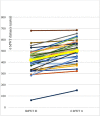First results from post-COVID inpatient rehabilitation
- PMID: 36756465
- PMCID: PMC9899863
- DOI: 10.3389/fresc.2022.1093871
First results from post-COVID inpatient rehabilitation
Abstract
Background: COVID-19 is associated with various symptoms and psychological involvement in the long term. In view of the multifactorial triggering and maintenance of the post-COVID syndrome, a multimodal therapy with somatomedical and psychotherapeutic content is expedient. This paper compares the psychological stress of post-COVID patients and their course in rehabilitation to psychosomatic and psychocardiological patients.
Method: Observational study with control-groups and clinical, standardized examination: psychological testing (BDI-II, HELATH-49), 6-MWT as somatic parameter, two measurement points (admission, discharge). Sample characteristics, including work related parameters, the general symptom-load and the course of symptoms during rehabilitation are evaluated.
Results: At admission in all measures post-COVID patients were significantly affected, but less pronounced than psychosomatic or psychocardiological patients (BDI-II post-COVID = 19.29 ± 9.03, BDI-II psychosomatic = 28.93 ± 12.66, BDI-II psychocardiology = 24.47 ± 10.02). During rehabilitation, in all complaint domains and sub-groups, symptom severity was significantly reduced (effect sizes ranging from d = .34 to d = 1.22). Medium positive effects were seen on self-efficacy (d = .69) and large effects on activity and participation (d = 1.06) in post-COVID patients. In the 6-MWT, the walking distance improved by an average of 76.43 ± 63.58 meters (d = 1.22). Not a single patient deteriorated in walking distance, which would have been a possible sign of post exercise malaise (PEM).
Conclusion: Post-COVID patients have a slighter psychological burden as psychocardiological or psychosomatic patients. Although rehabilitation is not curative, post-COVID patients benefit significantly from the interventions and there were no signs of PEM.
Keywords: inpatient rehabilitation; post-COVID-Syndrome; psychocardiology; psychosomatic; treatment effect.
© 2023 Kupferschmitt, Langheim, Tüter, Etzrodt, Loew and Köllner.
Conflict of interest statement
The authors declare that the research was conducted in the absence of any commercial or financial relationships that could be construed as a potential conflict of interest.
Figures

References
LinkOut - more resources
Full Text Sources
Research Materials

